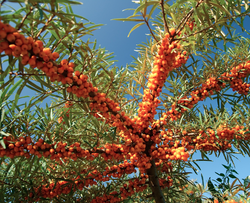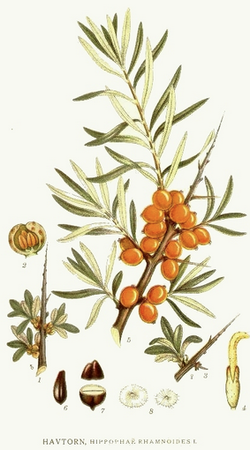 Hippophae rhamnoides, Sea Buckthorn Hippophae rhamnoides, Sea Buckthorn We can think of at least 180 great forest garden & perennial crops for cold climate Sweden. Want to hear about them? Over the course of the next year we will profile 5 a week on the blog. Perennial plants and crops offer a low energy, oil & resource input based foundation for future-proof agricultures. By default if an agriculture is to be called regenerative the bottom line is that it must be soil building, not soil depleting. Relentless deep tillage & poor soil husbandry (wifery?!) contributes to the majority of the 24 billion tons of topsoil lost every year on planet water. We are going to be focused on holistic polyculture grazing and perennial production at ridgedale over most of the site as this represents the most effective way to restore our degraded landscape, produce high value produce and ensure the future resource base we are managing holistically for in our decision making.  Genus Hippophae Species rhamnoides Common Name sea buckthorn Form shrub Habit running Origin Eurasia Light sun Moisture dry to mesic Edible fruit Nitrogen Yes Hippophae rhamnoides, or common sea-buckthorn, is a species of flowering plant in the family Elaeagnaceae, native to fixed dunes and sea cliffs in Europe and Asia. It is a spiny deciduous shrub. It can grow 2–4 m (7–13 ft) high. The leaves are alternate, narrow and lanceolate, with silvery-green upper faces. It is dioecious, which means that the male and female flowers grow on different shrubs. The male inflorescence is built up of four to six flowers without petals. The female inflorescence consists normally of only one flower without petals and contains one ovary and one ovule. Male plants need to be planted near the female plants to allow fertilisation and fruit production. The oval or lightly roundish fruits grow in compact grapes varying from pale yellow to dark orange and weighing from 0.2 g to 1 g. The plant has a very developed root system that can maintain the soil on high slopes. The roots live in symbiosis with actinomycetes. This relationship permits fixation of nitrogen from the air. They also transform insoluble organic and mineral matters from the soil to more soluble states. The rhizomes sucker rapidly to produce new colonies. Fruit can be eaten raw or cooked. It's very rich in vitamin C (120mg per 100g) and vitamin A, they are too acid when raw for most peoples tastes, though most children seem to relish them. Used for making fruit juice, it is high in vitamins and has an attractive aroma. It is being increasingly used in making fruit juices, especially when mixed with other fruits, because of its reputed health benefits. The fruits of some species and cultivars (not specified) contain up to 9.2% oil. It is best used before any frosts since the taste and quality of frosted berries quickly deteriorates. The twigs and leaves contain 4 - 5% tannin. They are astringent and vermifuge. The tender branches and leaves contain bio-active substances which are used to produce an oil that is quite distinct from the oil produced from the fruit. Yields of around 3% of oil are obtained. This oil is used as an ointment for treating burns. A high-quality medicinal oil is made from the fruit and used in the treatment of cardiac disorders, it is also said to be particularly effective when applied to the skin to heal burns, eczema and radiation injury, and is taken internally in the treatment of stomach and intestinal diseases. The fruit is astringent and used as a tonic. The freshly-pressed juice is used in the treatment of colds, febrile conditions, exhaustion etc[. The fruit is a very rich source of vitamins and minerals, especially in vitamins A, C and E, flavanoids and other bio-active compounds. It is also a fairly good source of essential fatty acids, which is fairly unusual for a fruit. It is being investigated as a food that is capable of reducing the incidence of cancer and also as a means of halting or reversing the growth of cancers[214]. The juice is also a component of many vitamin-rich medicaments and cosmetic preparations such as face-creams and toothpastes[9]. A decoction of the fruit has been used as a wash to treat skin irritation and eruptions[254]. OUR FRIENDS AT PFAF HAVE AN AMAZING DATABASE OF SPECIES (UK BASED);
1 Comment
Rick Larson
19/3/2014 09:46:16 pm
I have seeds stratifying and plants on order! Good to learn all these fine qualities.
Reply
Leave a Reply. |
Details
Like us on FB Below for regular updatesStay up to date with customized updates you want to receive
Upcoming coursesArchives
December 2016
Categories
All
|

 RSS Feed
RSS Feed